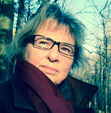Nina Munteanu's Blog, page 10
October 3, 2013
Watermark: the Meaning of Water...
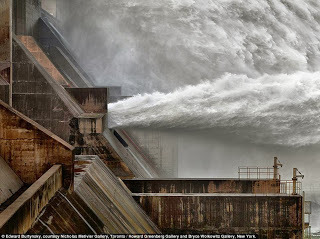 Xiaolangdi Dam, China
Xiaolangdi Dam, ChinaWater has been on my mind a lot lately.When I was five, I saw the Atlantic Ocean for the first time. It changed the way I look at water; I recall being fascinated by the sheer magnitude and power of it. How it created my world and covered so much of it. When I was thirty-five, I toured Africa for the first time. It changed the way I look at water. How without it I would not be alive. I spent over twenty-five years teaching about it at university and researching it and protecting it as a scientist and an environmental consultant. The mark that water has left on me has been great.Water is all around us. It’s in the air we breathe. It covers 70 percent of the Earth. We are made of mostly water. Here, in North America where water is generally plentiful, many of us tend to take it for granted. Not renowned Canadian photographer Edward Burtynsky. In fact, he’s made it part of his life’s work.
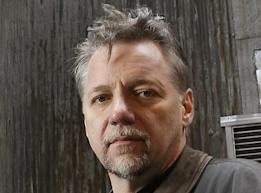 Edward BurtynskyLast night a friend took me to the Toronto International Film Festival to watch a feature documentary on water by Burtynsky and multiple-award winning filmmakers Jennifer Baichwal and Nick de Pencier. It was called Watermark. It changed the way I look at water.Shot in 5K ultra high-definition video, Watermark soars with truly breathtaking aerial perspectives, wide expanses and spectacular light. From its powerful opening scene of jetting spillway water from the Xiaolangdi Dam on the Yellow River, China, to the turbulent waters of the pristine rugged Stikine River valley of northern BC in the fall, Watermark features water in all its humble glory: as a powerful terraforming element, and “magnificent force of nature that we all too often take for granted—until it’s gone.”
Edward BurtynskyLast night a friend took me to the Toronto International Film Festival to watch a feature documentary on water by Burtynsky and multiple-award winning filmmakers Jennifer Baichwal and Nick de Pencier. It was called Watermark. It changed the way I look at water.Shot in 5K ultra high-definition video, Watermark soars with truly breathtaking aerial perspectives, wide expanses and spectacular light. From its powerful opening scene of jetting spillway water from the Xiaolangdi Dam on the Yellow River, China, to the turbulent waters of the pristine rugged Stikine River valley of northern BC in the fall, Watermark features water in all its humble glory: as a powerful terraforming element, and “magnificent force of nature that we all too often take for granted—until it’s gone.”
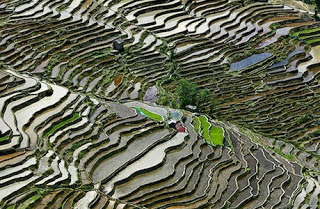 rice terraces, ChinaBurtynsky brought his eye for pattern, texture and light into this visually stunning movie that spans ten countries and twenty stories. Scenes flow from massive floating abalone farms off China’s Fujian coast to the construction site of the biggest arch dam in the world—the Xiluodu, six times the size of the Hoover. Images and scenes weave an evocative story. There is the barren desert delta where the Colorado River no longer reaches the ocean … The Panna Meena Stepwell of Rajasthan, India … The polluting leather tanneries of Dhaka … The U.S. Open of Surfing in Huntington Beach … the Kumbh Mela in Allahabad, where thirty million people gather for a sacred bath in the Ganges … Scientists drill ice cores two kilometers deep into the Greenland Ice Sheet … a lone water guardian walks the rice terraces of the Western Yunnan Province in China.Exploring pattern, filigree, light and relief, Watermark juxtaposes contrasting imagery—to tell an epic story. Take for instance, the two scenes in China, one of Xiluodu, the largest arch dam in the world, and the other China’s traditional rice patties in the Western Yunnan Province of China. They represent a new and an ancient perspective of the same phenomenon: how to divert and use water.
rice terraces, ChinaBurtynsky brought his eye for pattern, texture and light into this visually stunning movie that spans ten countries and twenty stories. Scenes flow from massive floating abalone farms off China’s Fujian coast to the construction site of the biggest arch dam in the world—the Xiluodu, six times the size of the Hoover. Images and scenes weave an evocative story. There is the barren desert delta where the Colorado River no longer reaches the ocean … The Panna Meena Stepwell of Rajasthan, India … The polluting leather tanneries of Dhaka … The U.S. Open of Surfing in Huntington Beach … the Kumbh Mela in Allahabad, where thirty million people gather for a sacred bath in the Ganges … Scientists drill ice cores two kilometers deep into the Greenland Ice Sheet … a lone water guardian walks the rice terraces of the Western Yunnan Province in China.Exploring pattern, filigree, light and relief, Watermark juxtaposes contrasting imagery—to tell an epic story. Take for instance, the two scenes in China, one of Xiluodu, the largest arch dam in the world, and the other China’s traditional rice patties in the Western Yunnan Province of China. They represent a new and an ancient perspective of the same phenomenon: how to divert and use water.
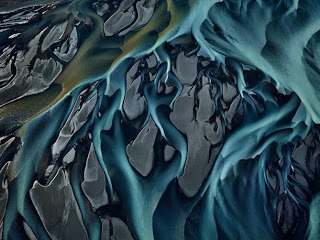 Thjorsa River, Iceland“Water has a unique capacity to express scale and detail simultaneously,” says filmmaker Jennifer Baichwal. “It can be a meandering, pastoral brook and the trickle from the edge of an ice sheet, or it can be a monumental force, like Niagara Falls and the Pacific Ocean.” Watermark is a visual essay that takes the aerial grandness of a powerful scene and roots it in the intimacy of the particular. This is a Burtynsky moniker: to show personal detail in the midst of epic grandness; to tease out story from the chaos.Many of the shots were taken from unique angles and often from above, demonstrating context and providing a global link that all of humanity can understand and resonate with. The documentary is more contemplation and presentation, less rhetoric or polemic. Yet, lingering in the shoals and quiet pools is a message.
Thjorsa River, Iceland“Water has a unique capacity to express scale and detail simultaneously,” says filmmaker Jennifer Baichwal. “It can be a meandering, pastoral brook and the trickle from the edge of an ice sheet, or it can be a monumental force, like Niagara Falls and the Pacific Ocean.” Watermark is a visual essay that takes the aerial grandness of a powerful scene and roots it in the intimacy of the particular. This is a Burtynsky moniker: to show personal detail in the midst of epic grandness; to tease out story from the chaos.Many of the shots were taken from unique angles and often from above, demonstrating context and providing a global link that all of humanity can understand and resonate with. The documentary is more contemplation and presentation, less rhetoric or polemic. Yet, lingering in the shoals and quiet pools is a message. There’s a reason why Burtynsky tells this story (both as movie and book). He’s Canadian. “In Canada we are never far from places where one can see how the land looks without our presence. Around the globe, this has become a rare perspective,” says Burtynsky.
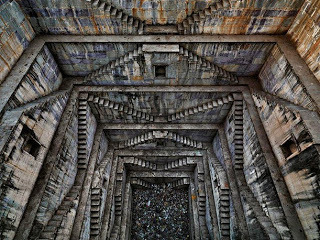 Stepwell, IndiaIn his article in the October 2013 issue of The Walrus, Burtynsky explains why he started taking pictures of the earth’s water, culminating in his book Burtynsky—Waterand the film Watermark: “The world’s population was 2.8 billion when I was born. Not quite six decades later, 7.2 billion humans inhabit the planet. This fact runs through almost all my photographs, but it became especially relevant when I started to think about taking pictures of the earth’s water.”“My photographs reflect the impact of humanity, not its absence. They are pictures of our footprint, and the diminishment of nature that results. They are distressed landscapes: images of land, and now of water, that we have altered, or diverted, or transformed, or used in this unprecedented period of population growth, agricultural expansion, and industrialization. Documenting the point of impact between humankind and its evolving environment has turned out to be a life’s work.”“Canada borders the Great Lakes, which contain 21 percent of the world’s fresh surface water,” writes Burtynsky. “The other one to three million lakes in this country (depending on your definition of “lake”) hold even more.” He contends that, “[Canada is] not an oil country. We are a water country. The implications and the responsibilities are enormous…We are custodians of over one-fifth of a resource that is utilitarian in the broadest and most necessary sense: water enables everything to live. Without it, there is wasteland—end of story.”
Stepwell, IndiaIn his article in the October 2013 issue of The Walrus, Burtynsky explains why he started taking pictures of the earth’s water, culminating in his book Burtynsky—Waterand the film Watermark: “The world’s population was 2.8 billion when I was born. Not quite six decades later, 7.2 billion humans inhabit the planet. This fact runs through almost all my photographs, but it became especially relevant when I started to think about taking pictures of the earth’s water.”“My photographs reflect the impact of humanity, not its absence. They are pictures of our footprint, and the diminishment of nature that results. They are distressed landscapes: images of land, and now of water, that we have altered, or diverted, or transformed, or used in this unprecedented period of population growth, agricultural expansion, and industrialization. Documenting the point of impact between humankind and its evolving environment has turned out to be a life’s work.”“Canada borders the Great Lakes, which contain 21 percent of the world’s fresh surface water,” writes Burtynsky. “The other one to three million lakes in this country (depending on your definition of “lake”) hold even more.” He contends that, “[Canada is] not an oil country. We are a water country. The implications and the responsibilities are enormous…We are custodians of over one-fifth of a resource that is utilitarian in the broadest and most necessary sense: water enables everything to live. Without it, there is wasteland—end of story.”
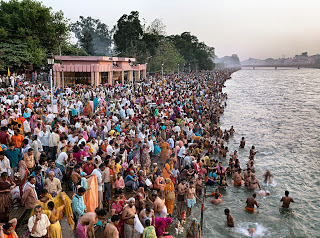 Allahabad, IndiaWatermark is a visual essay on this planet’s most valuable and mysterious component. It is a quiet exhortation to rethink our perspectives on an element that is both “common” and prized; an element that, if it were not here, would mark the violent end of all life. My upcoming book on water entitled Water Is…(due in Spring 2014 with Starfire) brings my over twenty-years experience as an aquatic ecologist to explore what water means to each of us:
Allahabad, IndiaWatermark is a visual essay on this planet’s most valuable and mysterious component. It is a quiet exhortation to rethink our perspectives on an element that is both “common” and prized; an element that, if it were not here, would mark the violent end of all life. My upcoming book on water entitled Water Is…(due in Spring 2014 with Starfire) brings my over twenty-years experience as an aquatic ecologist to explore what water means to each of us:I’m a limnologist. I study and help manage water in our environment; its flow, distribution, storage and properties. I look at how water changes the landscape, carving out huge valleys, forming deltas at river mouths, and polishing pebbles smooth on a lakeshore. I investigate the effects of its contamination by toxins, organic pollutants and disrespect. In its solid form, water has scraped out huge swaths of land and formed some of our largest lakes, dropping moraine till in places and melt water from ice blocks elsewhere. In its gaseous form, water controls climate and weather.
Water is the most common substance on Earth. Chemically, water is simply two atoms of hydrogen joined to one of oxygen. Simple. Not so simple.For something so “simply” made, water is pretty complex. Its unique properties make water possibly the most important element of our existence and in ways most of us can’t possibly imagine. Without water no life form could exist. Water is a universal solvent. It transports all kinds of things from the sediment of the Nile River to the oxygenated blood cells in your arteries. Water stores energy and heat. It responds to and changes the properties of all manner of things.
One of humanity’s greatest crimes is that we don’t treat water respectfully and with gratitude. It’s free, after all. It’s everywhere, isn’t it? “Water is the ultimate commons”, says author Barbara Kingsolver. That lack of respect and gratitude engenders subtle abuse. And that abuse spills into self-abuse. All life is made up of from 50 to 95 percent water with humans averaging 65 percent.We are water. What we do to water we do to ourselves…
So, what is water, really? And what does it mean to you and your loved ones?
Some see water as a commodity like everything else that can make them rich; they will claim it as their own to sell—yet it cannot be “owned” or kept. Ultimately, water will do its job to energize you and give you life then quietly take its leave; it will move mountains particle by particle with a subtle hand; it will paint the world with beauty then return to its fold and rejoice; it will travel through the universe and transform worlds; it will transcend time and space to share and teach.
Water is…
(excerpt from Water Is… by Nina Munteanu, Starfire World Syndicate, due Spring 2014)
Published on October 03, 2013 14:18
September 22, 2013
Monsanto and GMOs: a Model of Greed
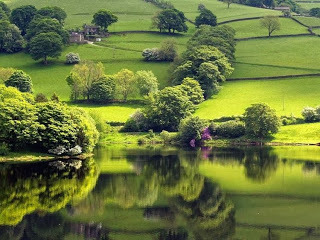 According to the David Suzuki Foundation, “companies that develop and patent GMO seeds are the same companies that develop and patent the pesticides and herbicides to which the unique seeds are resistant. Monsanto is the largest seed company in the world and owns about 86% of GMO seeds sown globally. It is also the parent of Roundup.” Suzuki adds that, “the safety of GMO foods is unproven and a growing body of research connects these foods with health concerns and environmental damage. For this reason, most developed nations have policies requiring mandatory labeling of GMO foods at the very least, and some have issued bans on GMO food production and imports.”
According to the David Suzuki Foundation, “companies that develop and patent GMO seeds are the same companies that develop and patent the pesticides and herbicides to which the unique seeds are resistant. Monsanto is the largest seed company in the world and owns about 86% of GMO seeds sown globally. It is also the parent of Roundup.” Suzuki adds that, “the safety of GMO foods is unproven and a growing body of research connects these foods with health concerns and environmental damage. For this reason, most developed nations have policies requiring mandatory labeling of GMO foods at the very least, and some have issued bans on GMO food production and imports.”In Canada we don’t require labeling of GMO products. Canadians are often unaware that the foods we choose contain GMO ingredients.
GMO Labeling & the Right to Know
On May 25, 2013, two million people in over 50 countries expressed outrage over Monsanto's desire to own the food supply through genetically-altered (and patented) seeds, according to Jonathan Landsman of Natural News.
 Rachel Parent on CBC TVFourteen-year old Canadian Rachel Parent was just awarded “Environmental Hero” by NOW Magazine in Toronto for her energetic work on “the right to know”. Parent is a fearless human rights advocate, journalist, speaker and Healthy Planet Watchdog. This mercurial energetic young woman founded the “Kids Right to Know—Just Label it!” campaign (www.gmo-news.com) and actively participates in the “conversation” on GMOs throughout Canada.
Rachel Parent on CBC TVFourteen-year old Canadian Rachel Parent was just awarded “Environmental Hero” by NOW Magazine in Toronto for her energetic work on “the right to know”. Parent is a fearless human rights advocate, journalist, speaker and Healthy Planet Watchdog. This mercurial energetic young woman founded the “Kids Right to Know—Just Label it!” campaign (www.gmo-news.com) and actively participates in the “conversation” on GMOs throughout Canada.Parent was a keynote speaker at the March Against Monsanto rally in Toronto the same day and discussed GMO labeling: “Over 60 countries around the world have mandatory GMO labeling, including China and Russia,” said Parent. “Canada and the US are the only two industrialized nations that don’t. In the countries that have mandatory labeling, products that contain GMOs are hardly found because people won’t buy them. In fact, over 30 countries have outright bans on GMOs.”
Parent cited Monsanto, Dow Chemical, Kellogg’s, Nestle, Kraft, Frito-Lay and PepsiCo among the companies that spent over $47 million in ad campaigns to defeat the California bill to label GMO products.
“The truth is,” said Parent, “it’s no coincidence that since GMOs have been introduced into our food system, we’ve started seeing more cases of irritable bowel syndrome, leaky gut syndrome, acid reflux, infertility, cancer, autism, Parkinson’s and many other diseases. Unfortunately, it seems like we’re all a big part of a science experiment.”
“Here in Canada,” said Parent, “[Monsanto is] putting thousands of conventional and organic farms at risk because of contamination by GMO crops. Their herbicides and pesticides are polluting our air and water and have contributed to the collapse of over 50% of our bee colonies. They’re responsible for a whole new species of super weeds and superbugs that have become Roundup resistant so now more and stronger toxic pesticides are being used.”
“All of this could lead up to be the most devastating, destructive, unspoken environmental catastrophe of all time,” she concluded. “Unfortunately, the media is not talking about it because most of their advertisers are brands that use GM ingredients. In fact, over 90% of the advertised packaged goods that are advertised on TV contain GMOs, such as corn, canola, soy, vegetable oils and high fructose corn syrup.”
On the heels of the recent failure of Proposition 37 in California, I was glad to hear that on June 3, 2013, Connecticut became the first US state to pass mandatory labeling legislation for genetically engineered food ingredients. The compromise law, however, requires that four other states pass similar legislation in order to “trigger” Connecticut’s labeling requirement. One of the states must share a border with Connecticut and their combined population must equal at least 20 million people.
Cultivating Cultural Genocide
Monsanto Company is a publicly traded American multinational agricultural biotechnology corporation and leading producer of genetically engineered (GE) seed and the herbicide glyphosate (marketed as Roundup). The company used to make DDT, PCBs, Agent Orange and recombinant bovine somatrotropin. It currently focuses on providing genetically modified seeds to farmers and agribusinesses. Monsanto’s biotechnology has created DNA-modified seeds that can endure pesticides and herbicides. They also created the “terminator seed”, which produces plants that will never yield fertile seeds. Monsanto was among the first to genetically modify a plant cell in 1983 and conducted field trials of genetically modified crops in 1987. Monsanto pioneered the biotechnology industry business model in agriculture, using techniques developed by Genentech and other biotech drug companies. In this model companies invest heavily in research and development and recoup the expenses through the use and enforcement of biological patents. In the 1980s Monsanto applied the model to agriculture as part of a growing movement to create a global, uniform system of plant breeder’s rights. This conflicted with the customary practices of farmers to save, reuse, share and develop plant varieties. Its seed-patenting model has been rightly criticized as biopiracy and threatens ecosystem biodiversity.
Parent effectively summarized the insidious nature of Monsanto’s business model: “Monsanto’s trying to change the way farming has been done for thousands of years by patenting their seeds and making it illegal to save or share seeds with other farmers. Do you know why? Because farmers have to buy new seeds from Monsanto every year. This makes it more expensive for farmers and ultimately for us, the consumers. And it gets worse because if some of Monsanto’s [seeds or pollen] fly over and cross-pollinate with seeds on a neighbouring field, Monsanto then sues the farmer for stealing their intellectual property. I know this sounds ridiculous and rather criminal of Monsanto, but it’s a reality for our farmers. Now [Monsanto is] trying to introduce GM alfalfa in Canada. Farmers are concerned that if it’s allowed it will contaminate all-natural alfalfa, which is a feedstock for animals. And so even organic meat and diary products could become contaminated with GMOs. The funny thing is there’s no need for GM alfalfa. Alfalfa naturally, without pesticides, keeps weeds down on its own. This is another case of Monsanto creating a solution for a problem that just doesn’t exist. All so they can sell more chemicals.”
Earlier this year, on March 26th, President Obama signed H.R. 933 with a provision called the Monsanto Protection Act. The Monsanto Protection Act protects Monsanto from being sued for health damages caused by the use of their genetically modified crops.
Maribel Hermosillo of Policymic adds that, “Monsanto's practices with GMO seeds can do more than just hurt the public health; they can also destroy traditional farming methods in communities around the world.”
The insidious nature of Monsanto’s GMO seed production is that, while their poster line is “we are feeding the hungry of the world”, they are, in fact, monopolizing the seed industry across the world through genetic engineering to create more revenue. It’s a simple model of greed.
In her article The Seeds of Suicide: How Monsanto Destroys Farming in Global Research, Dr. Vandana Shiva tells us that, “Control over seed is the first link in the food chain because seed is the source of life. When a corporation controls seed, it controls life, especially the life of farmers.”
Dr. Shiva adds, “Patents on seed are illegitimate because putting a toxic gene into a plant cell is not “creating” or “inventing” a plant. These are seeds of deception — the deception that Monsanto is the creator of seeds and life; the deception that while Monsanto sues farmers and traps them in debt, it pretends to be working for farmers’ welfare, and the deception that GMOs feed the world. GMOs are failing to control pests and weeds, and have instead led to the emergence of superpests and superweeds… A renewable resource became a non-renewable, patented commodity.”
“One way they have been able to monopolize the seed industry,” says Hermosillo, “is by cutting a deal with the International Monetary Fund (IMF). When countries are in debt, they can ask the IMF for loans to rejuvenate the economy. Some of the conditions of the IMF loan include sustainable practices the country must implement in order to revitalize the economy with western capitalistic development. However, one of the conditions of the IMF includes preferential access to markets by agricultural conglomerates such as Monsanto. Countries impacted by Monsanto include India, Mexico, Liberia and Paraguay.”
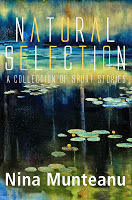 My 2007 short story Julia’s Gift explores a family’s personal tragedy—and a victorious outcome—during a turbulent post-GMO war between pro-biotechnologists and pro-naturalist Gaians.
My 2007 short story Julia’s Gift explores a family’s personal tragedy—and a victorious outcome—during a turbulent post-GMO war between pro-biotechnologists and pro-naturalist Gaians. Julia’s Giftappears in my short story collection Natural Selection, about the evolution of humanity and our planet, available on Amazon.ca, Amazon.com, Barnes & Noble and other quality bookstores in your area.
Published on September 22, 2013 08:47
September 9, 2013
Nina Munteanu Teaching Science Fiction Writing at George Brown College Toronto
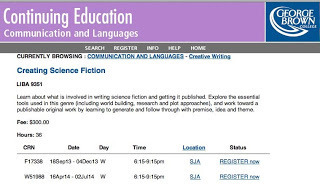 This fall I will be teaching a course on how to write science fiction at George Brown College in Toronto.
This fall I will be teaching a course on how to write science fiction at George Brown College in Toronto.The 12 week course that starts on Wednesday September 18th (6:15 to 9:15 pm) through to December 4th 2013 will focus on writing science fiction toward publication.
The Course will explore the essential tools used in the genre, including:
world buildingpremise and story promisestoryboardingplot approachesresearchideasthemelanguage and stylepromotion and marketing
The downtown George Brown campus is located on King Street in the heart of downtown Toronto.
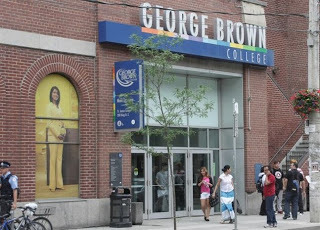
If you or anyone you know in the Toronto area with or without a WIP is looking to learn the essential tools of writing science fiction, then this is an ideal course for you. Sign up and tell your friends.
See you in class!
Published on September 09, 2013 21:30
August 22, 2013
Reaching for Elysium: Why the movie could have been great but wasn’t
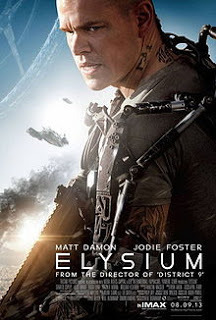 In the “Hero’s Journey” myth, Elysium (or the Elysium Fields in Greek mythology) is the paradise that true heroes go to when they die (think of Frodo in Lord of the Rings and the hero in The Gladiator). To the ancient Greeks, Elysium was a place at the ends of the earth where heroes, favored by the gods for their altruism, went. It is a state or place of perfect happiness; the equivalent of Heaven.
In the “Hero’s Journey” myth, Elysium (or the Elysium Fields in Greek mythology) is the paradise that true heroes go to when they die (think of Frodo in Lord of the Rings and the hero in The Gladiator). To the ancient Greeks, Elysium was a place at the ends of the earth where heroes, favored by the gods for their altruism, went. It is a state or place of perfect happiness; the equivalent of Heaven.Elysium is also the name given to the Earth-orbiting space station of Neill Blomkamp’s (District 9) new science fiction political allegory of the same name. Elysium is where the privileged live in luxury and perfect health (thanks to health-pods) — after they abandoned Earth to the squalor they no doubt helped create. This is not made clear enough for me and is one of the film’s major weaknesses, in my opinion (more on that below).
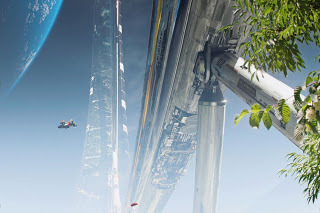 Earth seen from Elysium
Earth seen from ElysiumThe year is 2154 in a Los Angeles that strangely resembles the slum shanties of Johannesburg, South Africa (where Blomkamp filmed District 9). We soon learn that Earth struggles in the mire of humanity’s waste in a state of general social strife. Abandoned by the wealthy elite (who have moved to Elysium), the rest of an overpopulated humanity lives in the squalor of abject poverty without food, healthcare, or the motivation to live. I, for one, would have liked to know a little of how humanity devolved so dramatically on a planetary scale.
A Different Hero’s Journey
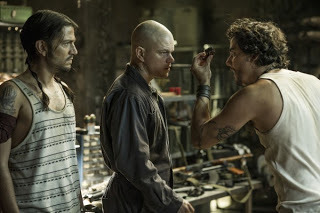 From the time he was a young orphan, Max Da Costa (Matt Damon; Maxwell Perry Cotton) dreamed of going to Elysium, its impressive phantom form visible in the daytime sky. He promised his childhood love Frey (sympathetically played by Alice Braga and Valentina Giros) that he would take her there, to paradise. His mentor, a kind mother-figure nun of the orphanage, gives him the hero’s talisman (a locket with a picture of Earth inside), and prophesizes, “Es su destino hacer algo maravilla cuando tu es hombre” ("It is your destiny to do something great when you are a man"). She reminds him that when he gets to Elysium, he will see the most beautiful thing: planet Earth. “You see how beautiful it is,” she says to him as he gazes out at the ghost of Elysium in the sky. Then, as she hands him the locket with Earth inside, she adds, “look how beautiful we are from there. Never forget where you come from.” Seen from this perspective, the planet Earth is a beautiful thing to behold.
From the time he was a young orphan, Max Da Costa (Matt Damon; Maxwell Perry Cotton) dreamed of going to Elysium, its impressive phantom form visible in the daytime sky. He promised his childhood love Frey (sympathetically played by Alice Braga and Valentina Giros) that he would take her there, to paradise. His mentor, a kind mother-figure nun of the orphanage, gives him the hero’s talisman (a locket with a picture of Earth inside), and prophesizes, “Es su destino hacer algo maravilla cuando tu es hombre” ("It is your destiny to do something great when you are a man"). She reminds him that when he gets to Elysium, he will see the most beautiful thing: planet Earth. “You see how beautiful it is,” she says to him as he gazes out at the ghost of Elysium in the sky. Then, as she hands him the locket with Earth inside, she adds, “look how beautiful we are from there. Never forget where you come from.” Seen from this perspective, the planet Earth is a beautiful thing to behold.Max is a reformed criminal who, like Blomkamp’s “workaday” anti-hero in District 9 (Sharlto Copley),
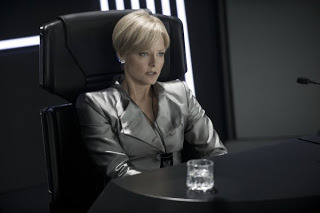 is not very hero-like until the last five minutes of the film, when he has his personal epiphany and decides to act altruistically rather than self-servingly. This is a pattern that Blomkamp has used before; the reluctant-hero (Wikus Van De Merwe) of District 9 was an unimpressive man with many obvious blemishes. A rather unlikeable man until he makes his heroic decision in the end. This is where Blomkamp’s heroes differ from most action movie heroes, who generally start their journey from higher positions on the evolutionary scale. Blomkamp’s heroes must journey farther to gain their hero-status; they are perhaps more realistic portrayals of ordinary men who finally shine under extra-ordinary circumstances. Men who we start out disliking—hating, even—but find ourselves cheering for, perhaps even crying for. Max’s behavior defines that true hero: rising from his need to save himself to his quest to save humanity—at the cost of his own life. But, as with the ordinary man, it is only when he connects a personal quest to save the daughter of his first love to his global quest to save Earth that Max transforms into the altruistic mythic hero he is destined to become. Everything came together at the film’s end, in a montage of scenes that depict the locket of the planet Earth in his dying hand (Earth is Home; save the planet), the demise of a police state, the savior of his love’s daughter, and med-pods landing on Earth to dispense aid to the dying masses.
is not very hero-like until the last five minutes of the film, when he has his personal epiphany and decides to act altruistically rather than self-servingly. This is a pattern that Blomkamp has used before; the reluctant-hero (Wikus Van De Merwe) of District 9 was an unimpressive man with many obvious blemishes. A rather unlikeable man until he makes his heroic decision in the end. This is where Blomkamp’s heroes differ from most action movie heroes, who generally start their journey from higher positions on the evolutionary scale. Blomkamp’s heroes must journey farther to gain their hero-status; they are perhaps more realistic portrayals of ordinary men who finally shine under extra-ordinary circumstances. Men who we start out disliking—hating, even—but find ourselves cheering for, perhaps even crying for. Max’s behavior defines that true hero: rising from his need to save himself to his quest to save humanity—at the cost of his own life. But, as with the ordinary man, it is only when he connects a personal quest to save the daughter of his first love to his global quest to save Earth that Max transforms into the altruistic mythic hero he is destined to become. Everything came together at the film’s end, in a montage of scenes that depict the locket of the planet Earth in his dying hand (Earth is Home; save the planet), the demise of a police state, the savior of his love’s daughter, and med-pods landing on Earth to dispense aid to the dying masses. A Story About the Planet Earth
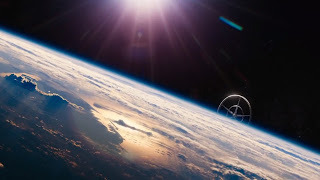 Ironically, it is to do with our beloved planet Earth that I felt in Elysium the most discord in plot/thematic story treatment and lack of resonance. Blomkamp begins with the planet and he ends his film with the planet. The symbolism is clear: in the stylish shots of Earth seen from Elysium (and vice versa); in the strategic scenes of Max and the image in his precious locket of not his childhood love Frey but of planet Earth; and his mentor’s advice to Max, delivered in one of the most powerful scenes of the movie. Yet, Blomkamp fails to follow through to give us that visceral connection. Why is the planet so important? How is Max connected to it or anyone else, for that matter. What is Spider’s story (Wagner Moura), a latter-day Che-Guevara, who fervently leads the proletarian rebellion of Earth? Who, why and how did the planet come to be so destroyed? There is not one ounce of suggestion, backstory or context. This is an important consideration; because without it, instead of feeling total resolution and redemption in the end, I felt a disconnect to those masses being helped and even some distrust in their fate and direction. Instead of feeling true victory, I felt ambivalence.
Ironically, it is to do with our beloved planet Earth that I felt in Elysium the most discord in plot/thematic story treatment and lack of resonance. Blomkamp begins with the planet and he ends his film with the planet. The symbolism is clear: in the stylish shots of Earth seen from Elysium (and vice versa); in the strategic scenes of Max and the image in his precious locket of not his childhood love Frey but of planet Earth; and his mentor’s advice to Max, delivered in one of the most powerful scenes of the movie. Yet, Blomkamp fails to follow through to give us that visceral connection. Why is the planet so important? How is Max connected to it or anyone else, for that matter. What is Spider’s story (Wagner Moura), a latter-day Che-Guevara, who fervently leads the proletarian rebellion of Earth? Who, why and how did the planet come to be so destroyed? There is not one ounce of suggestion, backstory or context. This is an important consideration; because without it, instead of feeling total resolution and redemption in the end, I felt a disconnect to those masses being helped and even some distrust in their fate and direction. Instead of feeling true victory, I felt ambivalence. Called a “sci-fi socialist film” by P.J. Gladnick of Newsbusters.org, Elysium is clearly an attempt at
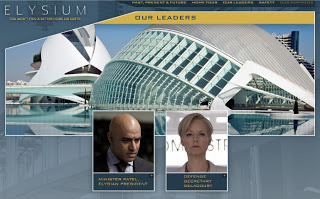 examining and dramatizing the social segregation of humanity and economic fascism: a dystopia that promises commentary on social and economic issues in society today. However, I felt that its delivery was compromised by Blomkamp’s choice to focus more on action tech at the expense of good backstory, context and empathic character development. I’m not saying that it’s a bad story. It is a very good story; it’s just that it could have been a great story. The heart of the story—delivered through the main protagonist—lacks the global connection it could have had. This is not, as some reviewers suggest, due to any infirmity of the hero, his antagonists, or lack of symbolism (of which there is much), but the lack of context, backstory and richness of setting (I’m not talking about the visible setting, which was spectacular, elegant and stylish). It comes back to how each character relates to “home”, the planet, and to each other.
examining and dramatizing the social segregation of humanity and economic fascism: a dystopia that promises commentary on social and economic issues in society today. However, I felt that its delivery was compromised by Blomkamp’s choice to focus more on action tech at the expense of good backstory, context and empathic character development. I’m not saying that it’s a bad story. It is a very good story; it’s just that it could have been a great story. The heart of the story—delivered through the main protagonist—lacks the global connection it could have had. This is not, as some reviewers suggest, due to any infirmity of the hero, his antagonists, or lack of symbolism (of which there is much), but the lack of context, backstory and richness of setting (I’m not talking about the visible setting, which was spectacular, elegant and stylish). It comes back to how each character relates to “home”, the planet, and to each other. 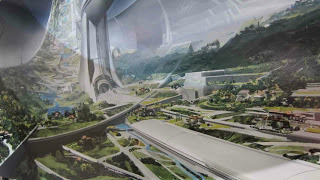 Matt Goldberg of Collider.com says that, “Elysium‘s message about economic inequality is couched in a finely-drawn sci-fi world, but the power of that message becomes diminished when we cease to care about the messenger.” Detroit News Tom Long added that, “Elysium is the sort of big, noisy sci-fi film that seems to want to say something but opts instead to concentrate on fight scenes involving gimmickry.” While I appreciated the depth and breadth of Blomkamp’s references to pop culture from an Armani-clad female Darth Vader to the Judeo-Christian references and symbolism, it just didn’t hold its promise.
Matt Goldberg of Collider.com says that, “Elysium‘s message about economic inequality is couched in a finely-drawn sci-fi world, but the power of that message becomes diminished when we cease to care about the messenger.” Detroit News Tom Long added that, “Elysium is the sort of big, noisy sci-fi film that seems to want to say something but opts instead to concentrate on fight scenes involving gimmickry.” While I appreciated the depth and breadth of Blomkamp’s references to pop culture from an Armani-clad female Darth Vader to the Judeo-Christian references and symbolism, it just didn’t hold its promise. What began as a promising exploration about an important social issue, devolved into a sequence of ever-escalating gratuitous gore and violence—clearly aimed for a different audience.
Published on August 22, 2013 20:49
August 16, 2013
Colliding at When Words Collide
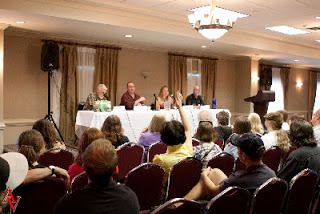 I just returned from Calgary’s premiere-quality writer’s festival:
When Words Collide
, this year in the Carriage House Inn August 9-11. It’s just the third year of the con and the first year I’ve participated. Organizers describe the conference as “a festival for readers, writers, artists and publishers of commercial and literary fiction, including genre, YA, children’s books, and poetry.”
I just returned from Calgary’s premiere-quality writer’s festival:
When Words Collide
, this year in the Carriage House Inn August 9-11. It’s just the third year of the con and the first year I’ve participated. Organizers describe the conference as “a festival for readers, writers, artists and publishers of commercial and literary fiction, including genre, YA, children’s books, and poetry.”I bumped into the Chairman, Randy McCharles, who shared with me that this literary
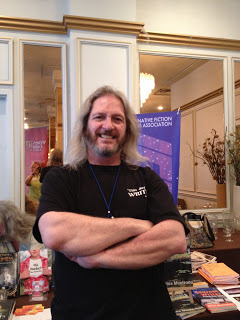 Randy McCharles, Chair of WWCconference, originally modelled after science fiction conventions, was conceived as a festival that doesn’t take itself too seriously. Which is part of its unique charm and success. This unassuming convention provides a friendly and accessible platform for professional writers, editors, novice writers and readers wishing to engage, learn and share. The festival provided over 190 hours of programming for readers, writers and publishers of all genres including science fiction and fantasy, mystery, non-fiction, screenwriting and poetry.
Randy McCharles, Chair of WWCconference, originally modelled after science fiction conventions, was conceived as a festival that doesn’t take itself too seriously. Which is part of its unique charm and success. This unassuming convention provides a friendly and accessible platform for professional writers, editors, novice writers and readers wishing to engage, learn and share. The festival provided over 190 hours of programming for readers, writers and publishers of all genres including science fiction and fantasy, mystery, non-fiction, screenwriting and poetry.I’m not surprised that When Words Collide is growing in leaps and bounds with each passing year. For two years in a row this festival was nominated for the Aurora Award, Canada’s premiere award for excellence in literature of the fantastic. 2013 special guests included Patricia Briggs, Michaal Cassutt, David B. Coe and D.B, Jackson, Barbara Fradkin, Shirlee Smith Matheson and Jamis Paulson, Penguin Canada Editor Adrienne Kerr, Robert J. Sawyer, & Publisher Brian Hades of Edge Books and so many more cool literary folk.
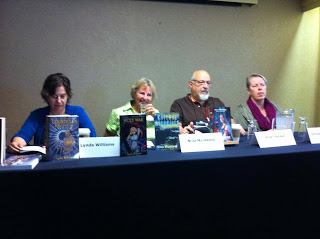 Programming scheduled me to participate in eight super cool panels, two workshops, a reading, autograph session, and Blue-Pencil Café. That didn’t stop me from bumping into old friends in the Peanuts Sports Pub or while loitering in the spacious lobby.
Programming scheduled me to participate in eight super cool panels, two workshops, a reading, autograph session, and Blue-Pencil Café. That didn’t stop me from bumping into old friends in the Peanuts Sports Pub or while loitering in the spacious lobby. Panels that I participated in spanned a wide
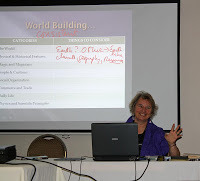 and topical range of subjects and issues Germaine to writers: anything from the burgeoning field of auditory books (where I shared my experience with Iambik's audiobooks of my Splintered Universe Trilogy), to topics like “Transhumanism”, “The Alien as Metaphor”, “Making the Everyday Fantastic”, “What Women Write”, to racism, sexism and homophobia in genre fiction—expertly moderated by Peter Halasz. Being a writing coach, I also participated in an editing panel moderated by Brian Hades, publisher of Edge Books, who received a call from a mystery guest during panel deliberations. I read from my newly released
Natural Selection
, a collection of short stories themed on the co-evolution of humanity with Nature and technology.
and topical range of subjects and issues Germaine to writers: anything from the burgeoning field of auditory books (where I shared my experience with Iambik's audiobooks of my Splintered Universe Trilogy), to topics like “Transhumanism”, “The Alien as Metaphor”, “Making the Everyday Fantastic”, “What Women Write”, to racism, sexism and homophobia in genre fiction—expertly moderated by Peter Halasz. Being a writing coach, I also participated in an editing panel moderated by Brian Hades, publisher of Edge Books, who received a call from a mystery guest during panel deliberations. I read from my newly released
Natural Selection
, a collection of short stories themed on the co-evolution of humanity with Nature and technology.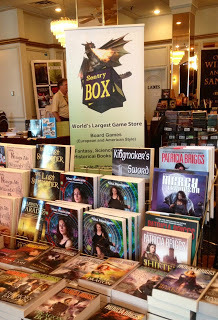
My two workshops “The Hero’s Journey” and “Self Editing” were well-attended and caused a small flurry over my writing guidebook The FictionWriter , which sold out right after my first workshop at The Sentry Box and the IFWA table, who were also selling my books.
My last activity was the Blue-Pencil Café, a one-on-one feedback coaching session for writers with a WIP. I enjoyed working with new writers on their interesting and imaginative writing projects.
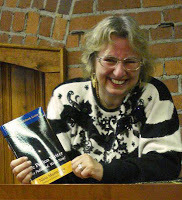 Nina clutching the last copy of The Fiction Writer
Nina clutching the last copy of The Fiction WriterThis writer’s festival is possibly the best writer's event I have had the pleasure to attend. It’s sophisticated but not pretentious; it’s diverse but not too chaotic (embracing the singularity of stable chaos and “strange attractors”); it’s edifying but not stuffy; it’s international but still down-home; and it’s loads of fun. If you are a serious writer wishing to hone your craft, find a great writing community, and share experiences and your passion for words, this is a very cool place to do it.
Mark your calendar for WWC 2014 and think of “colliding”.
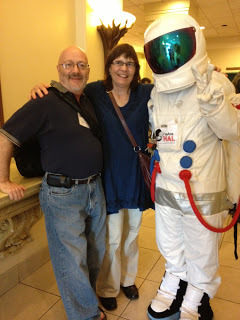 Rick and Di and special guestThe Fourth Annual Edition of
When Words Collide
will be August 8-10, 2014 at The Carriage House Inn, Calgary, AB. Special guests already booked include: Brandon Sanderson, Jacqueline Guest, Diana Gabaldon, D.J. McIntosh, Mark Leslie (Kobo Canada) and others.
Rick and Di and special guestThe Fourth Annual Edition of
When Words Collide
will be August 8-10, 2014 at The Carriage House Inn, Calgary, AB. Special guests already booked include: Brandon Sanderson, Jacqueline Guest, Diana Gabaldon, D.J. McIntosh, Mark Leslie (Kobo Canada) and others. I’ll be there too!
www.WhenWordsCollide.org.
Published on August 16, 2013 00:12
August 5, 2013
Nina Munteanu at When Words Collide

In a few days I’m heading for Calgary to participate in one
of Canada’s premiere writing conferences, the 3rd Annual When Words
Collide (WWC-2013): August 9-11, 2013 at the Carriage House Inn (9030 Macleod
Trail South, Calgary, AB).
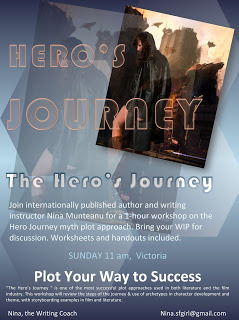 Winner of the 2012 Aurora Award and current nominee for the 2013 Aurora, WWC is a festival for readers, writers, artists and publishers of
Winner of the 2012 Aurora Award and current nominee for the 2013 Aurora, WWC is a festival for readers, writers, artists and publishers ofcommercial and literary fiction, including genre, YA, childrens books and
poetry. Readers and writers share information, learn, and build a sense of
community. The conference features experts representing diverse genres
including mystery, science fiction, fantasy, romance, literary, historical,
western, film scripts, and poetry.
The interesting nature of the conference is reflected in its
diverse and comprehensive Programming: writing, literature, publishing, art
(cover/interior); Kaffe klatches; pitch sessions, autograph sessions, readings,
Blue-pencil café; parties, and a merchant’s corner. The festival also includes
in-programming workshops (I’m doing two of them) and pre-conference workshops.
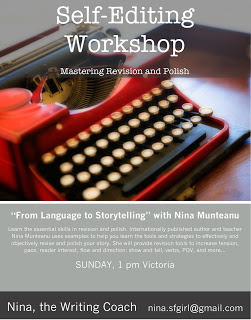
Featured guests of honor include: Patricia Briggs, Michael
Cassutt, David B. Coe, D.B. Jackson, Barbara Fradkin, Shirlee Smith Matheson,
and Jamis Paulson.
I will be sitting on several panels, giving a reading from
my latest SF book Inner Diverse (of The Splintered Universe Trilogy),
participating in an autograph session, Blue-pencil café and giving two writing
workshops:
·
The Hero’s Journey
·
Self-Editing
Nina’s Schedule at WWC-2013:
Friday 6 pm: PANEL—“Listening to Books”
Friday 9 pm: PANEL—“The Issue is the Issue”
Saturday 10 am: PANEL—“The Alien as Metaphor”
Saturday 11 am: PANEL—“Transhumanism”
Saturday 12 pm: PANEL—“Making the Everyday Fantastic”
Saturday 1 pm: READING—Reading from “Inner Diverse”
Saturday 2 pm: PANEL—“What Women Write”
Saturday 7 pm: PANEL—“Editor for Hire”
Saturday 8 pm: AUTOGRAPH SESSION
Sunday 10 am: PANEL—“Pantser, Plotter of Quilter”
Sunday 11 am: WORKSHOP—“The Hero’s Journey”
Sunday 1 pm: WORKSHOP—“Self-Editing”
Sunday 3 pm: BLUE-PENCIL CAFÉ
I’m looking forward to visiting with old friends and meeting
new ones. See you all there!
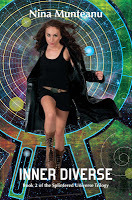
I will also be joining awesome voice artist Dawn Harvey for readings
of Inner Diverse of The Splintered Universe Trilogy on Thursday (August 8) at The
SENTRY BOX at 7 pm on and on Friday August 9th at Chapters (Chinook
Centre) at noon.
See you all there!
Published on August 05, 2013 19:59
July 27, 2013
Author's Night at Chapters-Indigo with Nina Munteanu
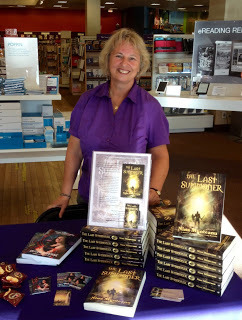
Nina Munteanu Signing at Chapters Richmond
Yesterday, Chapters-Indigo (Richport in Richmond) hosted an author's night, where I signed copies of The Last Summoner , my latest novel and first in the genre of fantasy (I'd published five science fiction books up to then). The Last Summoner (a Canadian Bestseller on Amazon) follows the tale of young 14 year old Vivianne Schoen, a baroness in medieval Poland who is chased as a witch through time into present day Paris, now ruled by Nazis.
I was joined at Chapters by five other cool authors for a book signing and discussion with readers.
We represented a great diversity of authors and works. Range of works included: speculative political SF graphic novel; contemporary literary women's fiction; hard science fiction and historical fantasy ( The Last Summoner ).
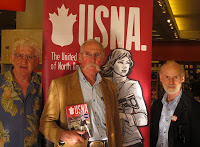
the Reel Write Bros.
Harry Kalensky, Davy Longworth and Allan Stanleigh signed copies of their graphic novel USNA . Set in a post Borg-like USA amalgamation of Canada ("we will absorb you..."), the story chronicles the rebellion of a few Canadians. When Lawyer Carol Wheeler and her teenage son encounter a rebel fugitive during a trip from Toronto to Calgary, their journey becomes a test of their courage and allegiances.
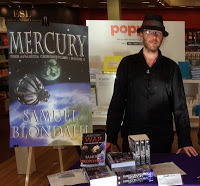
Samuel Blondahl
Samuel Blondahl signed copies of his hard science fiction novels Mercury and Mercury War (Books 1 and 2 of "The Anahita Chronicles"). This is an epic series in space exploration and colonization. When the stressed crew of the damaged starship Mercury stumble across a discovery, it shakes their understanding of the universe and their place in it.
Sarah Lane signed copies of her recent literary novel The God of My Art.
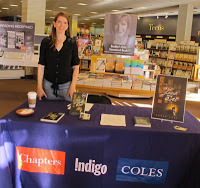
Sarah Lane
Lane's novel explores obsession with a lover as a source of artistic inspiration. Longlisted for the 2012 Amazon Breakthrough Novel Award, God of My Art "really takes off during a high and naked moment in a self-made steam hut in the woods," says Publishers Weekly.
****************************************************
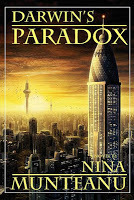
I was delighted to return to Chapters Richport in Richmond, where I had signed copies of my first book there in 2007: Darwin's Paradox . It was like coming home. Thanks, Andrew, Ryan and Cashmere; you were gracious hosts!
Published on July 27, 2013 10:37
July 24, 2013
Nina Munteanu Reads at Chapters Richport July 26th
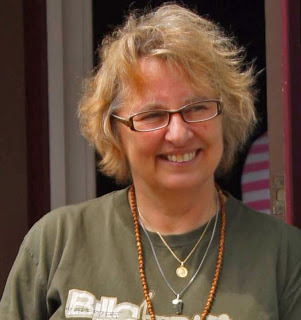
Join me at Chapters Richport (in Richmond, BC) for a reading and discussion of my historical fantasy The Last Summoner . I'll be joined by two other BC authors on July 26th from 5 to 8:30 pm in the Chapters store on Ackroyd Rd.
I tried to find out who the other two authors were but Chapters staff remained mysterious...OMG! Maybe one of them is William Gibson!
Or Robert J. Sawyer (he's from BC, isn't he?...I know, I know... but I see him here often enough! He's probably secretly Doctor Who #12 and uses his Tardis to skip the rush-hour crowd on the 401...Ok, 'fess up, Rob...)
Anyway...
Come and grab a Starbucks coffee or chai and join us for diverting discussion and some cool readings.
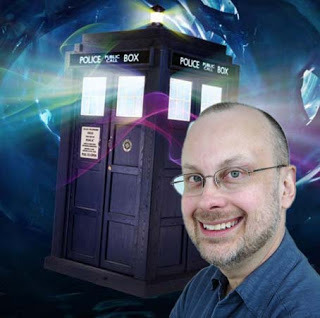
The Next Doctor Who? (Dr. Who #12)
I'll be reading from my historical fantasy The Last Summoner (Starfire). It's a medieval time travel tale that spans 600 years from Medieval Poland to present-day Paris. The story follows Baroness Vivianne Schoen, who discovers she can alter history--and she doesn't even have a Tardis! Alas, she's branded a witch and must flee through a time-space tear. Now in an alternate France ruled by Teutonic Knights, she must decide how to remake history.
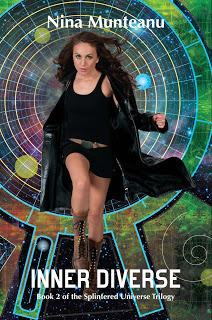
Nina's Book Tour:
The Chapters reading and signing in Metro Vancouver is part of my tour, which began in Toronto about a month ago (Chapters-Indigo in Yorkdale Mall and Markham) and will include Calgary, Alberta August 18 and 19 (Sentry Box and Chapters Chinook Centre, respectively) where I'll be giving some workshops and participating in panels and readings at the Aurora Award-winning writing conference "When Words Collide".
I'll be joined by Dawn Harvey at Sentry Box and Chapters in Calgary. Dawn is an awesome voice artist and will be reading from the newly released Iambik audiobook Inner Diverse , the second book of The Splintered Universe Trilogy, and from The Last Summoner .
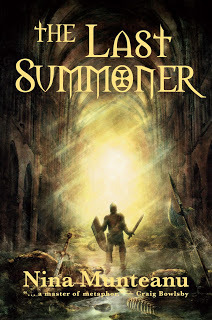
Published on July 24, 2013 16:34
July 22, 2013
When Art Tangos with Science
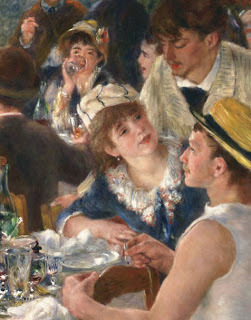
Imagination is more important than knowledge—Albert Einstein
I tell stories. I’m also a scientist. I use the scientific method in my research to seek truth; I also find truth presented to me through the symbols of intuition.
A few years ago, I was introduced to Krista Fogel, a University of British Columbia masters student, who was investigating the use of creative art in high-ability scientists. She named her thesis: “The Self-Perceived Experience of Investigating Science with an Artistic Spirit: A Hermeneutic Phenomenological Study of High Ability Scientists Who Also Engage in the Arts”. Hermeneutic, by the way, is the development and study of theories of the interpretation and understanding of texts (I had to look it up) and phenomenology is an approach to philosophy through the study of phenomena.
Krista wanted to interview me as part of her project. I was flattered, of course. Me, a High Ability Scientist? Who’d told her that? Once I got past my own humble angst, I found Krista’s questions bracing; they reopened a world of compelling ideas I had carried with me for some time. The concept of using art to do good science has dwelled inside me since registration day at Concordia University when I quit my fine arts program to pursue a science degree only to come full circle and write fiction. I got my Masters Degree in Ecology and Limnology and was then working as a scientist for an environmental consulting firm (I now write and teach writing full time). I did research, drove boats, collected samples and analyzed data then wrote up my findings and made recommendations. I wrote science fiction novels on the side.
“History shows that eminent scientists, such as Leonardo da Vinci, also engaged in the arts,” said Fogel. She went on to cite 400 other famous scientists who also practiced art at a high level. “If not entirely engaged in the arts, scientists throughout history have at least engaged in science with an artistic spirit. Scientists and artists use common tools for thinking such as intuition and imaginative processes.”
Krista and I met several times at the local Starbucks, where I “toked” on coffee as she fumbled with her notes. A young gal with a direct but unassuming gaze and a gentle smile, Krista asked me to share my personal experience of mixing art with science. Every good scientist is an artist at heart: science is the tool and art is the process.
Fogel concluded that when conducting scientific investigations with an artistic spirit, the scientist holds her heart central, from which the artist springs. This “allows us to connect with serendipitous occurrences, which breed discovery,” Fogel added.
You can train your mind as both artist and scientist to become more aware of serendipitous occurrences around you. I call it being in sync and wrote about it in an article on The Alien Next Door (“Writing in Sync”). Often, when I’m researching a novel, I pick up things serendipitously. Something will come up that just fits with what I was searching for. An article pops up in the news. Or I’m talking to someone and they bring up just the topic I am researching. These things always happen to me. This occurs not only in my fiction writing but in my scientific pursuits. Some years ago, I was doing a pollution study using glass slides for colonizing algae to compare communities of an urban stream to those of an agricultural stream. I was really looking to see the difference between communities of these different stream environments when I discovered that the algae were colonizing the glass surfaces according to the current. Compelled with more questions of why, how and what if, I pursued this new line of research (which turned out to be far more interesting than my original research premise) and wrote several ground-breaking papers on it.
Indeed, questions like “why” and “what if” are germane to both art and science; the ‘what if’ question is the science fiction writer’s mantra and the premise, which comes from the artist part of you: imagination and an inquisitive and open mind. The idea of seemingly unrelated events intersecting to produce meaningful patterns has spawned new notions of thought from the scientific study of spontaneous order in the universe (synchrony), to Synchromysticism — the discovery of convergent archetypal symbols in pop culture (e.g., books, music and film).
Writer and philosopher Jake Kotze suggests that, “Synchronicity happens when we notice the bleed-through from one seemingly separate thing into another — or when we for a brief moment move beyond the mind’s divisions of the world.” Synchronicity and serendipitous discovery, like metaphor, appears when we change the way we look at things.
Serendipitous discovery comes to us through peripheral vision. Like our muse, it doesn’t happen by chasing after it; it sneaks up on us when we’re not looking. It comes to us when we focus outward and embrace our wonder for this world. When we quiet our minds and nurture our souls with beauty. It is then that what we had been seeking naturally comes to us. Like a gift.
Author Sibyl Hunter tells us that “Sync operates as an undercurrent of divine awareness personified through the myriad processes and symbols that make up the building blocks of our reality. Within that current, we spin our modern-day myths into books, fairy tales and movies, subconsciously retelling ourselves the same story over and over.” This also holds true in the models and metaphors of scientific genius, which often spring from the creativity of an intuitive heart and imaginative mind.
According to Mark A. Runco (California State University) “creativity depends on originality, while accomplishment and achievement reflect other problem-solving skills. Creative thinking involves at least three things: 1) the cognitive capacity to transform experience into original interpretations, 2) an interest in producing original interpretations, and 3) discretion.” The title of Piaget’s monograph, To Understand Is to Invent, reflects the fact that we do not have an authentic understanding of our experience until we construct that understanding for ourselves. In other words, “it is one thing to memorize some datum; it is quite another to discover it for one’s self; only then do we understand,” says Runco. Fogel concurs: “what Piaget called inventionis a kind of creation, a creation of personal meaning. Piaget tied assimilation to imaginative play into creative interpretation.”
According to Dean Keith Simonton (University of California), even the most illustrious creative geniuses of history have careers riddled by both hits and misses, both successes and failures. He uses Albert Einstein as an example. A man who has achieved almost mythical status as a genius, Einstein’s career “was plagued by terrible ideas, false starts and surprising disasters.” Simonton tells the story of Einstein’s debate with Niels Bohr over the implications of quantum theory, in which Einstein offered a series of arguments that Bohr countered. Bohr once even pointed out that Einstein failed to take into consideration the theory of relativity! According to some, Einstein wasted the final years of his career working on a unified field theory that was almost universally rejected by his colleagues. Einstein defended his missteps by noting that errors can advance science so long as they are not trivial; the greater the error, the greater the opportunity for new perspective and discovery.
It is left for us to simply recognize the dance.
This article was previously published in Scribophile and A Hopeful Sign.
College of the Canyons teaches a course for K-12 teachers: "When Art and Science Tango"
Published on July 22, 2013 00:28
July 3, 2013
Natural Selection by Nina Munteanu Now Out
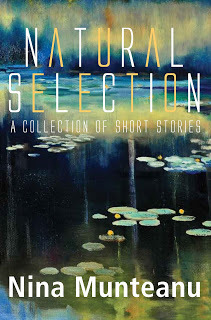
My collection of nine short stories was recently released through Pixl Press (Imprint of Starfire) in an anthology entitled "Natural Selection". The nine stories touch on various iterations of evolution, spanning a 20-year writing period starting in the 1980s with "Arc of Time" first published by The Armchair Aesthete in 2002 to "Julia's Gift" written in 2007, a significant year in my personal evolution.
Here's the book jacket description:
A man uses cyber-eavesdropping to make love. A technocratic government uses gifted people as tools to recast humanity. The ruins of a city serve as battleground between pro-technologists and pro-naturalists. From time-space guardians to cybersex, GMO, and biotech implants, this short story collection by science fiction novelist Nina Munteanu promises a journey of great scope, imagination and vision.
Of one of the stories, Tangent Online says: "Angel's Promises is a stunning example of good storytelling with an excellent setting and cast of characters."
"Natural Selection" is available at Amazon, Barnes & Noble and other quality bookstores near you.
Cover illustration is by Anne Moody and cover design is by Costi Gurgu
Published on July 03, 2013 00:04

